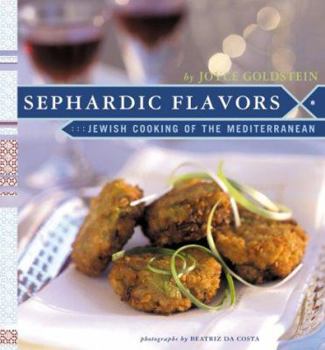Sephardic Flavors: Jewish Cooking of the Mediterranean
Chef, author, and Mediterranean cooking expert Joyce Goldstein follows her acclaimed "Cucina Ebraica: Flavors of the Italian Jewish Kitchen" with this remarkable exploration of Jewish cooking of the... This description may be from another edition of this product.
Format:Hardcover
Language:English
ISBN:0811826627
ISBN13:9780811826624
Release Date:September 2000
Publisher:Chronicle Books (CA)
Length:205 Pages
Weight:2.25 lbs.
Dimensions:0.9" x 8.6" x 9.4"
Customer Reviews
5 ratings
Great Sephardic cookbook
Published by Thriftbooks.com User , 14 years ago
Sephardic cookbooks are hard to come by. This book is out of print now, but it was easy enough to find inexpensively. Like all of Goldstein's books, the photography is exquisite and the recipes are simple, but creative. I love the menu planning pages at the beginning of the book and look forward to using these recipes to bring a bit of variety to the many Jewish gatherings I go to throughout the year.
great cookbook
Published by Thriftbooks.com User , 14 years ago
I love this cook book. The recipes were good and there was very interesting interesting historical notes about Sephardic Jews. I highly recomend
Varied food, beautifully presented
Published by Thriftbooks.com User , 17 years ago
We usually think one excellent dish is worth the price of a cookbook (think of the price you'd pay to eat an excellent dish at a restaurant), and we've made at least 3 or 4 out of this one already. Joyce Goldstein has also really sought out a nice variety of Sephardic cuisines. And the photographs are gorgeous.
Must Own
Published by Thriftbooks.com User , 22 years ago
Joyce Goldstein author and chef also understands the relationship between culture and food. Her book on Jewish Italian cooking should be read by anyone who likes to read cook books. In this book, Goldstein explores Sephardic food, the culinary heritage of Jews of the Middle East. She does not disapoint. The recipes are easy to follow and very tasty. The presentation is excellent and will make your mouth water. What is wonderful about all of Goldstein's work is you can see how Jews have, for centuries, absorbed the recipes of the culture in which they live, adapting them for their own tastes and dietery requirements. My wife and I have had a wonderful time cooking out of this book. The only problem is deciding what to make first.A great work.
A Fascinating Filling Exploration of Sephardic Cuisine
Published by Thriftbooks.com User , 23 years ago
Chef, author, restaurateur, and Mediterranean cooking specialist Joyce Goldstein follows her acclaimed Cucina Ebraica: Flavors of the Italian Jewish Kitchen with a study of Mediterranean Jewish cooking. While researching Cucina Ebraica, she immersed herself in Sephardic History. She wondered how the Jews evolved their cuisine, what influences they took from the Moors, the Portuguese, Andalusians, Valencians, Balearic Islanders, Greeks, Ottomans, and Balkans. What were the harmonizations to other communities and the contrasts to the Italian Jewish cuisine she was researching? She answers these questions and more in the book's opening collection of essays (about 22 pages). This is followed by several pages of sample full menus for Shabbat and Jewish holidays and commemorations. For example, there are Leek Fritters for Hanukkah, Mijavyani (a vegetable soup with plums) for Tu B'Shevat, Lentil Soup for Tisha B'Av, or Moussaka di Pesce and Macaroni and Cheese-Thrace Style (using feta and non-elbow Ziti) for Shavuot. If you are wondering how her book compares to DRIZZLE OF HONEY by David Gitlitz and Linda Kay Davidson, it is her feeling that while DRIZZLE is filled with fascintaing stories and history, her cookbook adds more culinary skills to the execution of recipes. The chapters include ones for Salads and Appetizers; Savory Pastries; Soups; Vegetables and Grains; Fish; Poultry and Meat; and Desserts. In the chapter for Salads and Appetizers, Goldstein writes, that Sephardic cuisine inverts the oil to vinegar ratio (3:1) with which most North Americans are familiar. Sephardic cooking is more tart, so the vinegar ratio is much higher (1:3). My favorite recipes were the Tarator (a cousin to Tzatziki) and Huevos HAMINados, or onion skin eggs, or Jewish eggs (Yahudi Yamurta). The chapter on savory pastries, which are also known as borekas, inchusa, tapada, rondanches, boyos, and filas (to name just a few), includes recipes for Izmir-style Handrajos, or Eggplant and Squash filled borekas. In her chapter on soups, Goldstein tells the reader that it is not a coincidence that the Spanish word for Jewess is the same for bean (judia). She provides recipes for several soups and adafina, or what some Jews may call cholent. My favorites included meatball soup, and a white bean soup. There are 24 recipes in the Vegetables and Grains chapter. Standouts are Turlu, a Turkish Ratatouille; a squash omelet fritada; and pumpkin and prunes, which resembles a Moroccan Jewish style Hilou. The tomato bread pudding was also very unique. A fish dish that is very interesting for the period between Simhat Torah and Hanukkah is Peshkado Avramila, or fish with sour plums or prunes. Goldstein writes that it recalls Abraham's self-circumcision, since Sephardic folklore says that Avraham sat under a plum tree after the procedure. The 22 meat and poultry recipes includes one for Gayna al Orno, a roast chicken with apples and pomegranates; and one for Keftas de Gayna,





